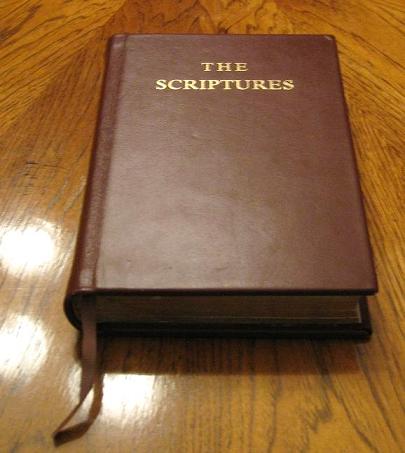

Rating
Scroll down to the bottom for pictures!
Summary of Features
Feature
Publication Date
1st Edition: 1993
Cover
Thick Brown Hardback
Size
8.86 inches tall
6 inches long
1.5 inches thick
Binding
Smyth-Sewn
Thumb-Index Tabs
Yes
Text Format
Verse Format
Headings
None
Mashiyach's Words in Red
No
Number of Ribbon Markers
1
Gold Gilded w/ Rounded Corners
Gold gilded, square corners
Extensive Cross References
No
Helps
Unfulfilled Prophecy Lines
12 Pages of Explanatory Notes
Appendix of Pagan Deities
Footnotes
Basic Cross References
Minimal Alternative Manuscript Readings
Prophecy Explanations
Basic Messianic/Sacred Name Notes
Concordance
No
Maps
No
Name of the Father
יַהְוֶה
Name of the Son
יֵשׁוּעַ
Hebrew Transliterations
All Names, Some Titles
Book Order
Hebrew Order
Torah
Prophets
Writings
Western Greek Order
Gospels/Acts
Pauline Epistles
General Epistles
Revelation
Base Text
None
Old Archaic English
No
Manuscript Origin
Hebrew Masoretic Text (primary)
Greek Byzantine Text (primary)
Greek Critical Text (consulted)
Review
Finally, a Messianic Sacred Name translation! Up until this point there has not been a complete Messianic version of the Scriptures at all. David Stern released his paraphrased Jewish New Testament, but The Scriptures by the Institute for Scripture Research (ISR) is the first complete Messianic version, and it is complete with the Sacred Names restored back into the text. Not only that, but they are written in the original Hebrew characters without vowel points so that people may pronounce them however they prefer. This is a very awesome feature and the first of it's kind! This sort of reverence for the name reminds me of the copies of the Dead Sea Scrolls they've found which, although written in an Aramaic type script, still contain YHWH's name in Paleo-Hebrew!
Now, The Scriptures is a very literal translation that seeks to most accurately translate the original manuscripts in a word for word manner. Many names and titles have also been transliterated to keep the richness of the Hebraic culture. This is most definitely NOT an antisemitic translation! Further, this is the first translation I have ever seen which strives to get rid of as much paganism as possible. In the preface it explains that many of the names we use for our Elohim in the English language are derived from pagan deities and as per Exodus 23:13 we should not even be saying those names! As it turns out, many other phrases and terms (such as holy) are of pagan sun-worship origin and do not reflect the original Hebrew or Aramaic word. This is all well documented in Dr.Chris Koster's book "The Final Reformation". What Dr.Koster has done here then is "purified" the translation which results in a fresh look at the Scriptures. By exploring the true meaning of words that we haven't understood much but nonetheless have gotten accustomed to them growing up in the church, it can be likened to reading the Scriptures for the first time again. This is a big reason to get a copy of this version!
The Tanakh portion of the Scriptures is based off of the Hebrew Masoretic Text and is aligned in it's correct order of Torah, Prophets and Writings. The Messianic Writings are based off of the Greek Majority Text (same as the King James Version) with revisions where appropriate from the Greek Critical Text (the one used in most modern versions). Dr.Koster believes in an underlying Hebrew original however and presents his case for this in the introduction. Also, having that in mind, he chooses to transliterate all names, places and concepts from a Hebraic perspective and not use any Greek/Hellenized words. This, like Sterns Jewish New Testament, adds a very important and much needed Hebraic atmosphere. As mentioned, all names and places are in their transliterated form rather than translated into an English equivalent, so you will see Yerushalayim instead of Jerusalem and Yehoshua instead of Joshua.
Another unique aspect to this translation is that the word Torah isn't always rendered as the traditional "law". Since it also means teaching or instruction, many places are more contextually correct in having it translated as such. This is another blessing that the Scriptures offers. You may be wondering though why, with all this praise, I have only given the translation 3.75/5. Let me take this opportunity to discuss some of the issues with the translation now. The literal style is sometimes too literal, and though I have little trouble with it, it does make it difficult for some readers. I also don't always agree with Dr.Koster's choice of words for translation. In one example, impale is put where you would usually see crucify. Messiah however was not impaled! Rather, he was executed by being nailed to a stake. I also don't necessarily agree with all of the footnotes. While they are interesting and helpful in learning more about Messianic Sacred Name doctrine, there are some questionable things found in some of the footnotes. Especially in the Messianic Writings. But, no commentary or translation is ever perfect, right?
One good thing is that The Scriptures is fairly conservative with it's insertion of YHWH's name into the Messianic Writings. Instead of replacing nearly every instance of Theos/God, it carefully inserts it in places where it most likely would have been in a Hebrew original (i.e. Tanakh quotes and places where Kurios/Lord is written when referencing the Father, etc.) However, without going to a Semitic manuscript that shows evidence of it's where abouts, it's still only guesswork and we run the risk of changing Scripture. This of course, is not a good thing.
However, one fantastic addition of YHWH's name is in the Tanakh where they restore it in the 134 places where the Masoretic scribes changed it to "Adonai", and some additional places where it was changed to "Elohim". The text which tells us about these changes also outline some other spots where the scribes "corrected" the text. The Scriptures attempts to restore the original readings before these so-called "corrections", but textual criticism shows that not all of the original readings were in fact the original readings. Dr.Koster should have checked with the Septuagint and Aramaic Tanakh.
One really cool feature of The Scriptures is the unfulfilled prophecy lines. Dr.Koster and those who helped him have gone through and made note of prophecies that have yet to be fulfilled. A line was then put in the margin where the prophecy is in the text. However, this is tricky since some prophecies have more than one fulfillment. Take for example the virgin in Yeshayahu 7:14 who bears a son. The word "almah" can mean both maiden and virgin, and in the lesser prophetic fulfillment it does mean maiden, but in the greater prophetic fulfillment with Messiah, it means virgin (I should note that The Scriptures translates it as "maiden" in both Yeshayahu 7:14 and Mattityahu 1:23). But here we see two fulfillments of the same prophecy occurring at different times in history. In that example, both prophecies have been fulfilled, but in other examples (such as things in Matthew, Daniel or Revelation) some things indeed have been fulfilled once and may be fulfilled again. Nonetheless, it's a very cool feature to have!
At the back, there is a section of explanatory notes (12 pages long) and a list of pagan deities. There is also a bibliography of texts that were helpful to Dr.Koster in putting this translation together. These sections are useful to compare to other material and again to get a grasp of Messianic Sacred Name doctrine.
Overall, this is one of the best Sacred Name translations available and the ONLY complete, literal, Messianic Sacred Name translation. There is absolutely no reason why you should not pick one up, and may YHWH bless you richly for doing so :)
Pictures
Click on an image for a bigger picture

The cover. The simple gold lettering is very eloquent. Notice that the ribbon marker is of a decent length.

The beautiful gold gilded edges. Here you can see the thumb index tabs and the thick brown hardcover. This hardcover is built to last!

A simple spine that speaks for itself. I personally love the simplicity.

Absolutely no issue turning open at the first book of Moshe. The other pages right from the start have no issue turning over flat. The quality can be likened to A.B. Traina's Holy Name Bible. It is very nice!
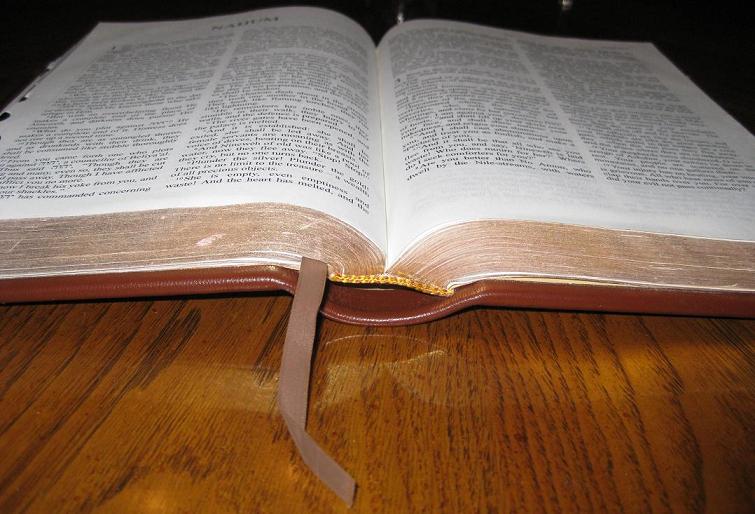
Here it is open flat. Again you can see the thickness of the hardcover and the gold gilded edges. The ribbon marker is cut in such a way that tries to avoid any fraying.
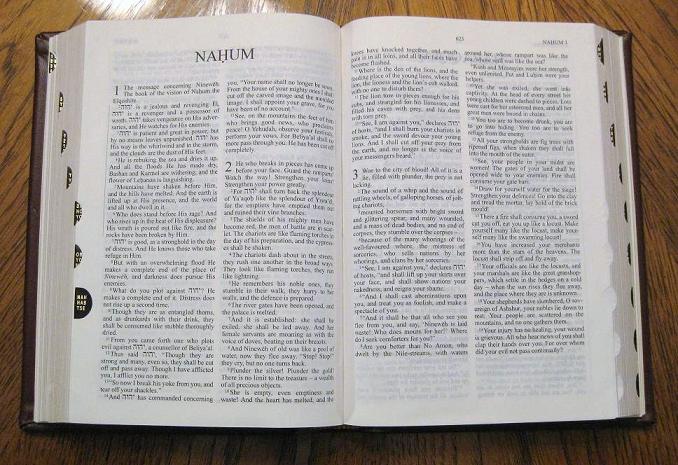
Here it is flat. Notice the verse format and marginal line indicating an unfulfilled prophecy.
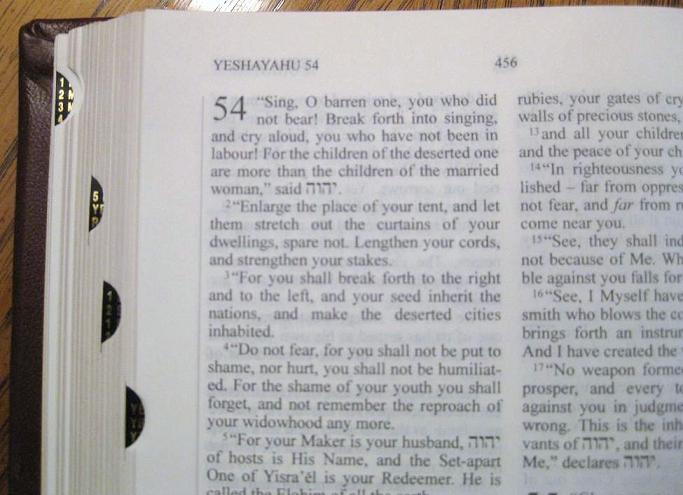
Here is the blessed name of our Creator in Hebrew Script, one of the best features of this translation!
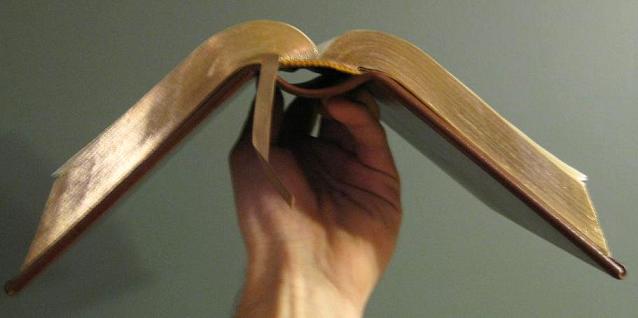
The flexibility is pretty good, not that for a hardcover it needs to be. Although not like the Holy Name Bible, there are no issues with it opening flat while reading on a table or for holding in the hands. With the sewn binding there are no issues with the pages.

Here it is held, and you can see that it is a very preferable size for carrying and reading.
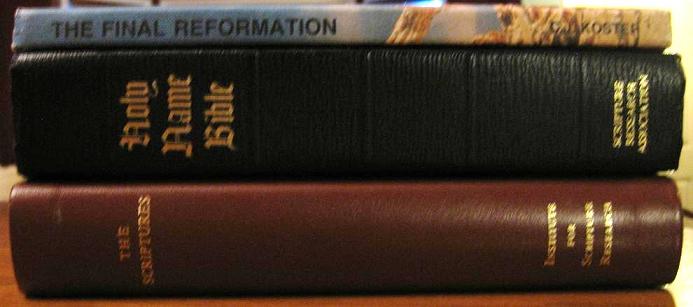
Here you can see The Scriptures compared to the Holy Name Bible and Dr.Koster's book "The Final Reformation". As you can see, they are all of the same height, but The Scriptures is thinner than the Holy Name Bible.
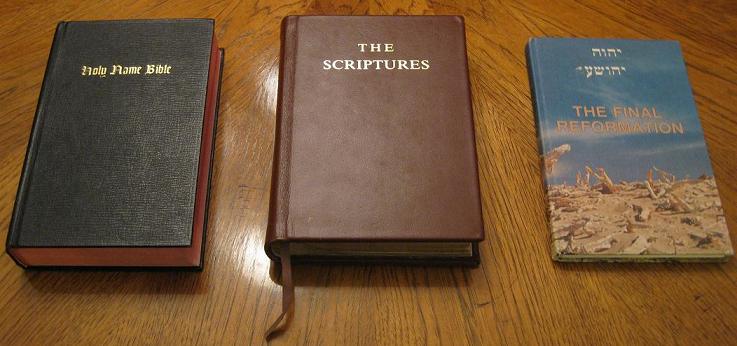
Here they are flat. The Scriptures is the widest of them but only by a little bit. As mentioned, it is the perfect size for carrying around and reading.
~~~~~~~~~~~~~~
RETURN TO HOME PAGE